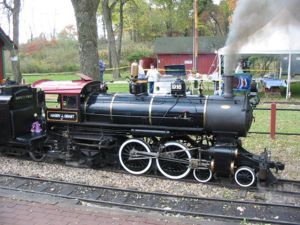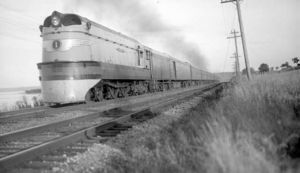4-4-2 (locomotive)

In the Whyte notation a 4-4-2 is a steam locomotive that has a two-axle leading truck, two powered driving axles and a one-axle trailing truck. This locomotive wheel arrangement is commonly called an Atlantic type.
The equivalent UIC classification is 2'B1'.
History
Atlantics were built expressly for passenger service. A number of railroads had extensive fleets of 4-4-2s for use in express, local and commute service. One of the best-known groups of 4-4-2s (after the Hiawatha engines) was the Pennsylvania Railroad's vast fleet of E class Atlantics culminating in the E6s class.
Atlantics were built with hauling wood-frame passenger cars in mind. Around the 1910s though, American railroads started buying steel passenger cars, which precipitated the introduction of the 4-6-2 Pacific type. Nonetheless, The Chicago and North Western, Southern Pacific and the Santa Fe railways used 4-4-2s until the bitter end of steam locomotive fleets in the 1950s.
Atlantics were ill-suited for mountain or very-long-distance operations. 4-4-2s had high-diameter driving wheels; in some cases exceeding 6 feet (1.8 m) which were perfect for 70 to 100 mph (113 to 161 km/h) runs. Climbing any railroad grade required a lower driver diameter or more drivers.
Hiawatha service
The Milwaukee Road made extensive use of the Atlantic type on its midwestern Hiawatha passenger trains; 4 locomotives of class A were constructed in 1935. One locomotive of this type typically hauled as many as 10 passenger cars behind it at speeds up to 100 mph. The railroad's Atlantics featured streamlined shrouds that made them a distinctive sight due to noted industrial designer Otto Kuhler on the tracks.
Steam locomotive types | |
|---|---|
| Single engine types | 0-2-2 • 2-2-0 • 2-2-2 • 2-2-4 • 4-2-0 • 4-2-2 • 4-2-4 • 6-2-0 0-4-0 • 0-4-2 • 0-4-4 • 2-4-0 • 2-4-2 • 2-4-4 • 4-4-0 • 4-4-2 • 4-4-4 0-6-0 • 0-6-2 • 0-6-4 • 2-6-0 • 2-6-2 • 2-6-4 • 2-6-6 • 4-6-0 • 4-6-2 • 4-6-4 0-8-0 • 0-8-2 • 0-8-4 • 2-8-0 • 2-8-2 • 2-8-4 • 2-8-6 • 4-8-0 • 4-8-2 • 4-8-4 • 4-8-6 • 6-8-6 0-10-0 • 0-10-2 • 2-10-0 • 2-10-2 • 2-10-4 • 4-10-0 • 4-10-2 0-12-0 • 2-12-0 • 2-12-2 • 2-12-4 • 4-12-2 • 4-14-4 |
| Duplex engine types | 4-4-4-4 • 6-4-4-6 • 4-4-6-4 • 4-6-4-4 |
| Garratt (articulated) types | 0-4-0+0-4-0 • 2-6-0+0-6-2 • 4-6-2+2-6-4 • 2-8-0+0-8-2 • 4-8-2+2-8-4 • 4-8-4+4-8-4 |
| Mallet (articulated) types | 0-4-4-0 • 0-4-4-2 • 2-4-4-2 0-6-6-0 • 2-6-6-0 • 2-6-6-2 • 2-6-6-4 • 2-6-6-6 • 2-6-8-0 • 4-6-6-2 • 4-6-6-4 0-8-8-0 • 2-8-8-0 • 2-8-8-2 • 2-8-8-4 • 4-8-8-2 • 4-8-8-4 2-10-10-2 • 2-8-8-8-2 • 2-8-8-8-4 |



